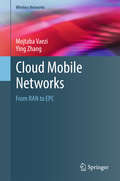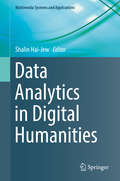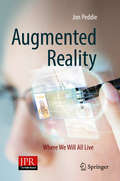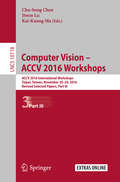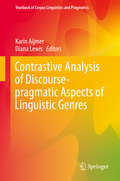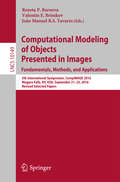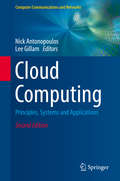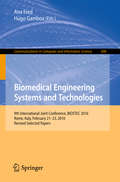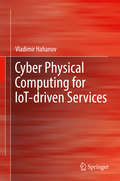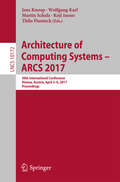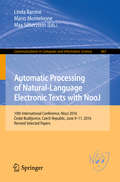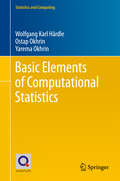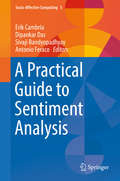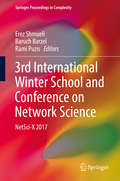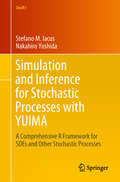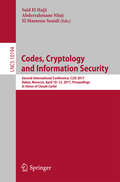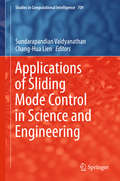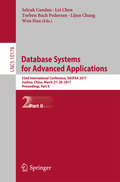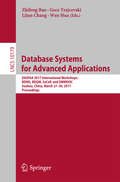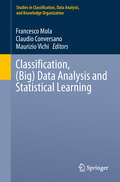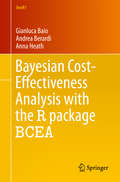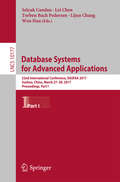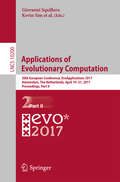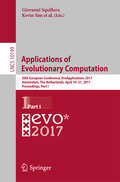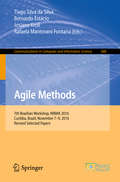- Table View
- List View
Cloud Mobile Networks: From RAN to EPC (Wireless Networks)
by Ying Zhang Mojtaba VaeziThis book explores the challenges and opportunities in exploiting cloud technologies for 5G, ranging from radio access network (RAN) to the evolved packet core (EPC). With a specific focus on cloud RAN and EPC, the text carefully explains the influence of recent network technologies such as software defined networking (SDN), visualization, and cloud technologies in the evolution of architecture for future mobile networks. The book discusses the causes, benefits and challenges of cloud RAN and its interplay with other evolving technologies for future mobile networks. Researchers and professionals involved in mobile technology or cloud computing will find this book a valuable resource. The text is also suitable for advanced-level students studying all types of networking.
Data Analytics in Digital Humanities (Multimedia Systems and Applications)
by Shalin Hai-JewThis book covers computationally innovative methods and technologies including data collection and elicitation, data processing, data analysis, data visualizations, and data presentation. It explores how digital humanists have harnessed the hypersociality and social technologies, benefited from the open-source sharing not only of data but of code, and made technological capabilities a critical part of humanities work. Chapters are written by researchers from around the world, bringing perspectives from diverse fields and subject areas. The respective authors describe their work, their research, and their learning. Topics include semantic web for cultural heritage valorization, machine learning for parody detection by classification, psychological text analysis, crowdsourcing imagery coding in natural disasters, and creating inheritable digital codebooks. Designed for researchers and academics, this book is suitable for those interested in methodologies and analytics that can be applied in literature, history, philosophy, linguistics, and related disciplines. Professionals such as librarians, archivists, and historians will also find the content informative and instructive.
Augmented Reality: Where We Will All Live
by Jon PeddieThis book provides an in-depth exploration of the field of augmented reality (AR) in its entirety and sets out to distinguish AR from other inter-related technologies like virtual reality (VR) and mixed reality (MR). The author presents AR from its initial philosophies and early developments, to its current technologies and its impact on our modern society, to its possible future developments; providing readers with the tools to understand issues relating to defining, building, and using our perception of what is represented in our perceived reality, and ultimately how we assimilate and react to this information. Augmented Reality: Where We Will All Live can be used as a comprehensive guide to the field of AR and provides valuable insights for technologists, marketers, business managers, educators and academics who are interested in the field of augmented reality; its concepts, history, practices and the science behind this rapidly advancing field of research and development.
Computer Vision – ACCV 2016 Workshops: ACCV 2016 International Workshops, Taipei, Taiwan, November 20-24, 2016, Revised Selected Papers, Part III (Lecture Notes in Computer Science #10118)
by Chu-Song Chen Jiwen Lu Kai-Kuang MaThe three-volume set, consisting of LNCS 10116, 10117, and 10118, contains carefully reviewed and selected papers presented at 17 workshops held in conjunction with the 13th Asian Conference on Computer Vision, ACCV 2016, in Taipei, Taiwan in November 2016. The 134 full papers presented were selected from 223 submissions. LNCS 10116 contains the papers selected
Contrastive Analysis of Discourse-pragmatic Aspects of Linguistic Genres (Yearbook of Corpus Linguistics and Pragmatics #5)
by Karin Aijmer Diana LewisThis volume will give readers insight into how genres are characterised by the patterns of frequency and distribution of linguistic features across a number of European languages. The material presented in this book will also stimulate further corpus-based contrastive research including more languages, more genres and different types of corpora. This is the first special issue of the Yearbook of Corpus Linguistics and Pragmatics, a publication that addresses the interface between the two disciplines and offers a platform to scholars who combine both methodologies to present rigorous and interdisciplinary findings about language in real use. Corpus linguistics and Pragmatics have traditionally represented two paths of scientific thought, parallel but often mutually exclusive and excluding. Corpus Linguistics can offer a meticulous methodology based on mathematics and statistics, while Pragmatics is characterized by its effort in the interpretation of intended meaning in real language.
Computational Modeling of Objects Presented in Images. Fundamentals, Methods, and Applications: 5th International Symposium, CompIMAGE 2016, Niagara Falls, NY, USA, September 21-23, 2016, Revised Selected Papers (Lecture Notes in Computer Science #10149)
by Reneta P. Barneva Valentin E. Brimkov João Manuel R.S. TavaresThis book constitutes the refereed post-conference proceedings of the 5th International Conference on Computational Modeling of Objects Presented in Images, CompIMAGE 2016, held in Niagara Falls, NY, USA, in September 2016. The 18 revised full papers presented together with 1 invited paper were carefully reviewed and selected from 30 submissions. The papers cover the following topics: theoretical contributions and application-driven contributions.
Cloud Computing: Principles, Systems and Applications (Computer Communications and Networks)
by Lee Gillam Nick AntonopoulosCloud computing continues to emerge as a subject of substantial industrial and academic interest. Although the meaning and scope of "cloud computing" continues to be debated, the current notion of clouds blurs the distinctions between grid services, web services, and data centers, among other areas. Clouds also bring considerations of lowering the cost for relatively bursty applications to the fore. Cloud Computing: Principles, Systems and Applications is an essential reference/guide that provides thorough and timely examination of the services, interfaces and types of applications that can be executed on cloud-based systems. The book identifies and highlights state-of-the-art techniques and methods for designing cloud systems, presents mechanisms and schemes for linking clouds to economic activities, and offers balanced coverage of all related technologies that collectively contribute towards the realization of cloud computing. With an emphasis on the conceptual and systemic links between cloud computing and other distributed computing approaches, this text also addresses the practical importance of efficiency, scalability, robustness and security as the four cornerstones of quality of service. Topics and features: explores the relationship of cloud computing to other distributed computing paradigms, namely peer-to-peer, grids, high performance computing and web services; presents the principles, techniques, protocols and algorithms that can be adapted from other distributed computing paradigms to the development of successful clouds; includes a Foreword by Professor Mark Baker of the University of Reading, UK; examines current cloud-practical applications and highlights early deployment experiences; elaborates the economic schemes needed for clouds to become viable business models. This book will serve as a comprehensive reference for researchers and students engaged in cloud computing. Professional system architects, technical managers, and IT consultants will also find this unique text a practical guide to the application and delivery of commercial cloud services. Prof. Nick Antonopoulos is Head of the School of Computing, University of Derby, UK. Dr. Lee Gillam is a Lecturer in the Department of Computing at the University of Surrey, UK.
Biomedical Engineering Systems and Technologies: 9th International Joint Conference, BIOSTEC 2016, Rome, Italy, February 21–23, 2016, Revised Selected Papers (Communications in Computer and Information Science #690)
by Ana Fred Hugo GamboaThis book contains the best papers of the First International Joint Conference on B- medical Engineering Systems and Technologies (BIOSTEC 2008), organized by the Institute for Systems and Technologies of Information Control and Communication (INSTICC), technically co-sponsored by the IEEE Engineering in Medicine and Bi- ogy Society (EMB), ACM SIGART and the Workflow Management Coalition (WfMC), in cooperation with AAAI. The purpose of the International Joint Conference on Biomedical Engineering S- tems and Technologies is to bring together researchers and practitioners, including engineers, biologists, health professionals and informatics/computer scientists, int- ested in both theoretical advances and applications of information systems, artificial intelligence, signal processing, electronics and other engineering tools in knowledge areas related to biology and medicine. BIOSTEC is composed of three co-located conferences; each specializes in one of the aforementioned main knowledge areas, namely: * BIODEVICES (International Conference on Biomedical Electronics and - vices) focuses on aspects related to electronics and mechanical engineering, - pecially equipment and materials inspired from biological systems and/or - dressing biological requirements. Monitoring devices, instrumentation sensors and systems, biorobotics, micro-nanotechnologies and biomaterials are some of the technologies addressed at this conference.
Cyber Physical Computing for IoT-driven Services
by Vladimir HahanovThis book presents the cyber culture of micro, macro, cosmological, and virtual computing. The book shows how these work to formulate, explain, and predict the current processes and phenomena monitoring and controlling technology in the physical and virtual space. The authors posit a basic proposal to transform description of the function truth table and structure adjacency matrix to a qubit vector that focuses on memory-driven computing based on logic parallel operations performance. The authors offer a metric for the measurement of processes and phenomena in a cyberspace, and also the architecture of logic associative computing for decision-making and big data analysis. The book outlines an innovative theory and practice of design, test, simulation, and diagnosis of digital systems based on the use of a qubit coverage-vector to describe the functional components and structures. Authors provide a description of the technology for SoC HDL-model diagnosis, based on Test Assertion Blocks Activated Graph. Examples of cyber-physical systems for digital monitoring and cloud management of social objects and transport are proposed. A presented automaton model of cosmological computing explains the cyclical and harmonious evolution of matter-energy essence, and also a space-time form of the Universe.
Architecture of Computing Systems - ARCS 2017: 30th International Conference, Vienna, Austria, April 3–6, 2017, Proceedings (Lecture Notes in Computer Science #10172)
by Martin Schulz Thilo Pionteck Jens Knoop Wolfgang Karl Koji InoueThis book constitutes the proceedings of the 30th International Conference on Architecture of Computing Systems, ARCS 2017, held in Vienna, Austria, in April 2017. The 19 full papers presented in this volume were carefully reviewed and selected from 42 submissions. They were organized in topical sections entitled: resilience; accelerators; performance; memory systems; parallelism and many-core; scheduling; power/energy.
Automatic Processing of Natural-Language Electronic Texts with NooJ: 10th International Conference, NooJ 2016, České Budějovice, Czech Republic, June 9-11, 2016, Revised Selected Papers (Communications in Computer and Information Science #667)
by Max Silberztein Linda Barone Mario MonteleoneThis book constitutes the refereed proceedings of the 9th International Conference, NooJ 2015, held in Minsk, Belarus, in June 2015. NooJ 2015 received 51 submissions. The 20 revised full papers presented in this volume were carefully reviewed and selected from the 35 papers that were presented at the conference. The papers are organized in topical sections on corpora, vocabulary and morphology; syntax and semantics; application.
Basic Elements of Computational Statistics (Statistics and Computing)
by Wolfgang Karl Härdle Ostap Okhrin Yarema OkhrinThis textbook on computational statistics presents tools and concepts of univariate and multivariate statistical data analysis with a strong focus on applications and implementations in the statistical software R. It covers mathematical, statistical as well as programming problems in computational statistics and contains a wide variety of practical examples. In addition to the numerous R sniplets presented in the text, all computer programs (quantlets) and data sets to the book are available on GitHub and referred to in the book. This enables the reader to fully reproduce as well as modify and adjust all examples to their needs. The book is intended for advanced undergraduate and first-year graduate students as well as for data analysts new to the job who would like a tour of the various statistical tools in a data analysis workshop. The experienced reader with a good knowledge of statistics and programming might skip some sections on univariate models and enjoy the various ma thematical roots of multivariate techniques. The Quantlet platform quantlet. de, quantlet. com, quantlet. org is an integrated QuantNet environment consisting of different types of statistics-related documents and program codes. Its goal is to promote reproducibility and offer a platform for sharing validated knowledge native to the social web. QuantNet and the corresponding Data-Driven Documents-based visualization allows readers to reproduce the tables, pictures and calculations inside this Springer book.
A Practical Guide to Sentiment Analysis (Socio-Affective Computing #5)
by Erik Cambria Dipankar Das Sivaji Bandyopadhyay Antonio FeracoSentiment analysis research has been started long back and recently it is one of the demanding research topics. Research activities on Sentiment Analysis in natural language texts and other media are gaining ground with full swing. But, till date, no concise set of factors has been yet defined that really affects how writers' sentiment i. e. , broadly human sentiment is expressed, perceived, recognized, processed, and interpreted in natural languages. The existing reported solutions or the available systems are still far from perfect or fail to meet the satisfaction level of the end users. The reasons may be that there are dozens of conceptual rules that govern sentiment and even there are possibly unlimited clues that can convey these concepts from realization to practical implementation. Therefore, the main aim of this book is to provide a feasible research platform to our ambitious researchers towards developing the practical solutions that will be indeed beneficial for our society, business and future researches as well.
3rd International Winter School and Conference on Network Science: NetSci-X 2017 (Springer Proceedings in Complexity)
by Erez Shmueli Baruch Barzel Rami PuzisThis book contains original research chapters related to the interdisciplinary field of complex networks spanning biological and environmental networks, social, technological, and economic networks. Many natural phenomena can be modeled as networks where nodes are the primitive compounds and links represent their interactions, similarities, or distances of sorts. Complex networks have an enormous impact on research in various fields like biology, social sciences, engineering, and cyber-security to name a few. The topology of a network often encompasses important information on the functionality and dynamics of the system or the phenomenon it represents. Network science is an emerging interdisciplinary discipline that provides tools and insights to researchers in a variety of domains. NetSci-X is the central winter conference within the field and brings together leading researchers and innovators to connect, meet, and establish interdisciplinary channels for collaboration. It is the largest and best known event in the area of network science. This text demonstrates how ideas formulated by authors with different backgrounds are transformed into models, methods, and algorithms that are used to study complex systems across different domains and will appeal to researchers and students within in the field.
Simulation and Inference for Stochastic Processes with YUIMA: A Comprehensive R Framework for SDEs and Other Stochastic Processes (Use R!)
by Stefano M. Iacus Nakahiro YoshidaThe YUIMA package is the first comprehensive R framework based on S4 classes and methods which allows for the simulation of stochastic differential equations driven by Wiener process, Lévy processes or fractional Brownian motion, as well as CARMA, COGARCH, and Point processes. The package performs various central statistical analyses such as quasi maximum likelihood estimation, adaptive Bayes estimation, structural change point analysis, hypotheses testing, asynchronous covariance estimation, lead-lag estimation, LASSO model selection, and so on. YUIMA also supports stochastic numerical analysis by fast computation of the expected value of functionals of stochastic processes through automatic asymptotic expansion by means of the Malliavin calculus. All models can be multidimensional, multiparametric or non parametric.The book explains briefly the underlying theory for simulation and inference of several classes of stochastic processes and then presents both simulation experiments and applications to real data. Although these processes have been originally proposed in physics and more recently in finance, they are becoming popular also in biology due to the fact the time course experimental data are now available. The YUIMA package, available on CRAN, can be freely downloaded and this companion book will make the user able to start his or her analysis from the first page.
Codes, Cryptology and Information Security: Second International Conference, C2SI 2017, Rabat, Morocco, April 10–12, 2017, Proceedings - In Honor of Claude Carlet (Lecture Notes in Computer Science #10194)
by Abderrahmane Nitaj Said El Hajji El Mamoun SouidiThis book constitutes the proceedings of the First International Conference on Codes, Cryptology and Information Security, C2SI 2015, held in Rabat, Morocco, in May 2015. The 22 regular papers presented together with 8 invited talks were carefully reviewed and selected from 59 submissions. The first aim of this conference is to pay homage to Thierry Berger for his valuable contribution in teaching and disseminating knowledge in coding theory and cryptography in Morocco since 2003. The second aim of the conference is to provide an international forum for researchers from academia and practitioners from industry from all over the world for discussion of all forms of cryptology, coding theory and information security.
Applications of Sliding Mode Control in Science and Engineering (Studies in Computational Intelligence #709)
by Sundarapandian Vaidyanathan Chang-Hua LienGathering 20 chapters contributed by respected experts, this book reports on the latest advances in and applications of sliding mode control in science and engineering. The respective chapters address applications of sliding mode control in the broad areas of chaos theory, robotics, electrical engineering, physics, chemical engineering, memristors, mechanical engineering, environmental engineering, finance, and biology. Special emphasis has been given to papers that offer practical solutions, and which examine design and modeling involving new types of sliding mode control such as higher order sliding mode control, terminal sliding mode control, super-twisting sliding mode control, and integral sliding mode control. This book serves as a unique reference guide to sliding mode control and its recent applications for graduate students and researchers with a basic knowledge of electrical and control systems engineering.
Database Systems for Advanced Applications: 22nd International Conference, DASFAA 2017, Suzhou, China, March 27-30, 2017, Proceedings, Part II (Lecture Notes in Computer Science #10178)
by Wen Hua Torben Bach Pedersen Lijun Chang Selçuk Candan Lei ChenDASFAA is an annual international database conference, located in the Asia- Paci?cregion,whichshowcasesstate-of-the-artR & Dactivities in databases- tems and their applications. It provides a forum for technical presentations and discussions among database researchers, developers and users from academia, business and industry. DASFAA 2009, the 14th in the series, was held during April 20-23, 2009 in Brisbane, Australia. In this year, we carefully selected six workshops, each focusing on speci?c research issues that contribute to the main themes of the DASFAA conference. Thisvolumecontainsthe?nalversionsofpapersacceptedforthesesixworkshops that were held in conjunction with DASFAA 2009. They are: - First International Workshop on Benchmarking of XML and Semantic Web Applications (BenchmarX 2009) - Second International Workshop on Managing Data Quality in Collaborative Information Systems (MCIS 2009) - First International Workshop on Data and Process Provenance (WDPP 2009) - First International Workshop on Privacy-Preserving Data Analysis (PPDA 2009) - FirstInternationalWorkshoponMobileBusinessCollaboration(MBC2009) - DASFAA 2009 PhD Workshop All the workshops were selected via a public call-for-proposals process. The workshop organizers put a tremendous amount of e?ort into soliciting and - lecting papers with a balance of high quality, new ideas and new applications. We asked all workshops to follow a rigid paper selection process, including the procedure to ensure that any Program Committee members are excluded from the paper review process of any paper they are involved with. A requirement about the overall paper acceptance rate of no more than 50% was also imposed on all the workshops.
Database Systems for Advanced Applications: DASFAA 2017 International Workshops: BDMS, BDQM, SeCoP, and DMMOOC, Suzhou, China, March 27-30, 2017, Proceedings (Lecture Notes in Computer Science #10179)
by Wen Hua Lijun Chang Zhifeng Bao Goce TrajcevskiThis two volume set LNCS 10177 and 10178 constitutes the refereed proceedings of the 22nd International Conference on Database Systems for Advanced Applications, DASFAA 2017, held in Suzhou, China, in March 2017. The 73 full papers, 9 industry papers, 4 demo papers and 3 tutorials were carefully selected from a total of 300 submissions. The papers are organized around the following topics: semantic web and knowledge management; indexing and distributed systems; network embedding; trajectory and time series data processing; data mining; query processing and optimization; text mining; recommendation; security, privacy, senor and cloud; social network analytics; map matching and spatial keywords; query processing and optimization; search and information retrieval; string and sequence processing; stream date processing; graph and network data processing; spatial databases; real time data processing; big data; social networks and graphs.
Classification, (Studies In Classification, Data Analysis, And Knowledge Organization Ser.)
by Maurizio Vichi Francesco Mola Claudio ConversanoThis edited book focuses on the latest developments in classification, statistical learning, data analysis and related areas of data science, including statistical analysis of large datasets, big data analytics, time series clustering, integration of data from different sources, as well as social networks. It covers both methodological aspects as well as applications to a wide range of areas such as economics, marketing, education, social sciences, medicine, environmental sciences and the pharmaceutical industry. In addition, it describes the basic features of the software behind the data analysis results, and provides links to the corresponding codes and data sets where necessary. This book is intended for researchers and practitioners who are interested in the latest developments and applications in the field. The peer-reviewed contributions were presented at the 10th Scientific Meeting of the Classification and Data Analysis Group (CLADAG) of the Italian Statistical Society, held in Santa Margherita di Pula (Cagliari), Italy, October 8–10, 2015.
Bayesian Cost-Effectiveness Analysis with the R package BCEA (Use R!)
by Gianluca Baio Andrea Berardi Anna HeathThe book provides a description of the process of health economic evaluation and modelling for cost-effectiveness analysis, particularly from the perspective of a Bayesian statistical approach. Some relevant theory and introductory concepts are presented using practical examples and two running case studies. The book also describes in detail how to perform health economic evaluations using the R package BCEA (Bayesian Cost-Effectiveness Analysis). BCEA can be used to post-process the results of a Bayesian cost-effectiveness model and perform advanced analyses producing standardised and highly customisable outputs. It presents all the features of the package, including its many functions and their practical application, as well as its user-friendly web interface. The book is a valuable resource for statisticians and practitioners working in the field of health economics wanting to simplify and standardise their workflow, for example in the preparation of dossiers in support of marketing authorisation, or academic and scientific publications.
Database Systems for Advanced Applications: 22nd International Conference, DASFAA 2017, Suzhou, China, March 27-30, 2017, Proceedings, Part I (Lecture Notes in Computer Science #10177)
by Wen Hua Torben Bach Pedersen Lijun Chang Selçuk Candan Lei ChenDASFAA is an annual international database conference, located in the Asia- Paci?cregion,whichshowcasesstate-of-the-artR & Dactivities in databases- tems and their applications. It provides a forum for technical presentations and discussions among database researchers, developers and users from academia, business and industry. DASFAA 2009, the 14th in the series, was held during April 20-23, 2009 in Brisbane, Australia. In this year, we carefully selected six workshops, each focusing on speci?c research issues that contribute to the main themes of the DASFAA conference. Thisvolumecontainsthe?nalversionsofpapersacceptedforthesesixworkshops that were held in conjunction with DASFAA 2009. They are: - First International Workshop on Benchmarking of XML and Semantic Web Applications (BenchmarX 2009) - Second International Workshop on Managing Data Quality in Collaborative Information Systems (MCIS 2009) - First International Workshop on Data and Process Provenance (WDPP 2009) - First International Workshop on Privacy-Preserving Data Analysis (PPDA 2009) - FirstInternationalWorkshoponMobileBusinessCollaboration(MBC2009) - DASFAA 2009 PhD Workshop All the workshops were selected via a public call-for-proposals process. The workshop organizers put a tremendous amount of e?ort into soliciting and - lecting papers with a balance of high quality, new ideas and new applications. We asked all workshops to follow a rigid paper selection process, including the procedure to ensure that any Program Committee members are excluded from the paper review process of any paper they are involved with. A requirement about the overall paper acceptance rate of no more than 50% was also imposed on all the workshops.
Applications of Evolutionary Computation: 19th European Conference, Evoapplications 2016, Porto, Portugal, March 30 -- April 1, 2016, Proceedings, Part I (Lecture Notes in Computer Science #9597)
by Kevin Sim Giovanni SquilleroThis book constitutes the refereed conference proceedings of the 18th International Conference on the Applications of Evolutionary Computation, EvoApplications 2015, held in Copenhagen, Spain, in April 2015, colocated with the Evo 2015 events EuroGP, EvoCOP, and EvoMUSART. The 72 revised full papers presented were carefully reviewed and selected from 125 submissions. EvoApplications 2015 consisted of the following 13 tracks: EvoBIO (evolutionary computation, machine learning and data mining in computational biology), EvoCOMNET (nature-inspired techniques for telecommunication networks and other parallel and distributed systems), EvoCOMPLEX (evolutionary algorithms and complex systems), EvoENERGY (evolutionary computation in energy applications), EvoFIN (evolutionary and natural computation in finance and economics), EvoGAMES (bio-inspired algorithms in games), EvoIASP (evolutionary computation in image analysis, signal processing, and pattern recognition), EvoINDUSTRY (nature-inspired techniques in industrial settings), EvoNUM (bio-inspired algorithms for continuous parameter optimization), EvoPAR (parallel implementation of evolutionary algorithms), EvoRISK (computational intelligence for risk management, security and defence applications), EvoROBOT (evolutionary computation in robotics), and EvoSTOC (evolutionary algorithms in stochastic and dynamic environments).
Applications of Evolutionary Computation: 19th European Conference, Evoapplications 2016, Porto, Portugal, March 30 -- April 1, 2016, Proceedings, Part I (Lecture Notes in Computer Science #9597)
by Kevin Sim Giovanni SquilleroThis book constitutes the refereed conference proceedings of the 18th International Conference on the Applications of Evolutionary Computation, EvoApplications 2015, held in Copenhagen, Spain, in April 2015, colocated with the Evo 2015 events EuroGP, EvoCOP, and EvoMUSART. The 72 revised full papers presented were carefully reviewed and selected from 125 submissions. EvoApplications 2015 consisted of the following 13 tracks: EvoBIO (evolutionary computation, machine learning and data mining in computational biology), EvoCOMNET (nature-inspired techniques for telecommunication networks and other parallel and distributed systems), EvoCOMPLEX (evolutionary algorithms and complex systems), EvoENERGY (evolutionary computation in energy applications), EvoFIN (evolutionary and natural computation in finance and economics), EvoGAMES (bio-inspired algorithms in games), EvoIASP (evolutionary computation in image analysis, signal processing, and pattern recognition), EvoINDUSTRY (nature-inspired techniques in industrial settings), EvoNUM (bio-inspired algorithms for continuous parameter optimization), EvoPAR (parallel implementation of evolutionary algorithms), EvoRISK (computational intelligence for risk management, security and defence applications), EvoROBOT (evolutionary computation in robotics), and EvoSTOC (evolutionary algorithms in stochastic and dynamic environments).
Agile Methods: 7th Brazilian Workshop, WBMA 2016, Curitiba, Brazil, November 7-9, 2016, Revised Selected Papers (Communications in Computer and Information Science #680)
by Tiago Silva da Silva Bernardo Estácio Josiane Kroll Rafaela Mantovani FontanaThis book constitutes revised selected papers from the 7th Brazilian Workshop on Agil Methods, WBMA 2016, held in Curitiba, Brazil, in November 2016. The 10 full and 4 short papers presented in this volume were carefully reviewed and selected from 35 submissions. The papers present empirical results and literature reviews on agile implementation in government and distributed environments, design thinking and projects inception, testing and technical debt, motivation and gamification, training, modeling and project management, maturity models and quality assurance.
